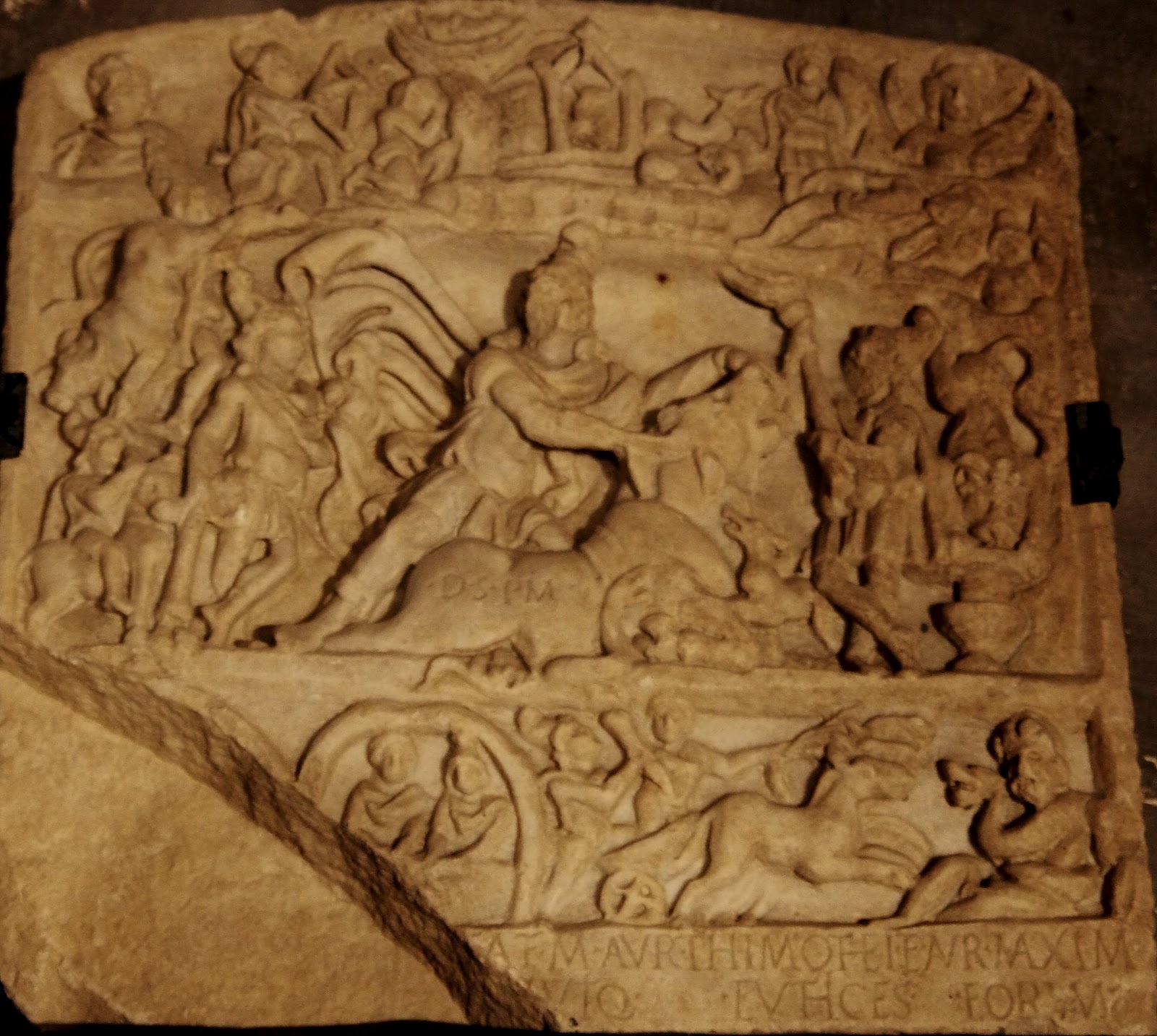
CIMRM 1935-1936 - Tauroctony of M. Aurelius Timotheus. Sibiu, Romania

CIMRM entry
APULUM When visiting Alba Julia in 1958 I had the intension to map out the find-spots the many Mithraic monuments of Apulum. This proved to be impossible as most of the exact find-spots are unknown. Therefore I divided the monuments into two groups: those found at Mures Port (= Maros-Porto) south of the castrum, and those found in the vicus north, east and south-east of the actual Alba Julia.
At Mures Port there were originally the canabae; under Marcus Aurelius we find here the Municipium Aur. Apulense which became Colonia (Aur.) Apulensis after A.D.180.
The vicus became a second Municipium under Septimius Severus and Colonia Nova Apulensis under Decius. From this last Colonia came the finds made by Ariosto and made near the "Galgenberg" where the Roman Camp was (see in general C. Daicoviciu, Le Transylvanie dans l'Antiquite, Bucarest 1945, 128f n. 4)
1935.
Relief in marble (H. 0.625 Br. 0.63 D. 0.08-0.06) found at Alba Julia in Mures Port together with the following monument in the 18th century. Sibiu (= Nagy Szeben = Hermannstadt), Museum Brukenthal (Inv. No. 7162). I am highly indebted to Mr. N. Lupu, Director of the Museum, for his permission to take photographs.
Bartalis, Imp. Dac., 83 gives a proveniance Mures Port, which Köppen, Nachricht 14 X and Pl. II No. 4 incorrectly changes in Sarmizegetusa lateron followed by others as Neugebaur; de Hammer, Mithriaca 90, 9 and Pl. VII; Müller, Mithras, fig. 19; Lajard, Basrelief de Transylvanie, 58ff and Pl. I, 1; Lajard, Intr., Pl. XCVI; Neugebaur in Sb. Akad. Wien 1851, 285 No. 3; Neugebaur, Dac., 38f No. 112; MMM II 308ff No. 192 and fig. 167; MM, Pl. II, 5; Saxl, 32 and fig. 97; Cserni, 335f and fig. 43. See fig. 505.
The relief is divided into three parts by horizontal rims. In the centre Mithras slaying the bull which wears a belt. The dog, snake and scorpion. The raven perches on the god's cloak. Below the cloak an indistinct object. Both torchbearers are in Oriental dress and cross-legged. Cautopates possibly holds a scorpion in his l.h. Behind him are representations of Mithras riding the bull and of Mithras taurophorus. Behind Cautes (r), who with both hands holds a burning torch upwards, a krater is represented above which a lion in vertical position. Above the lion a youthful Mithras being born from the rock; he holds a knife (l.h.) and a burning torch in the upraised hands.
In the upper part from l. to r. :
1) The dressed bust of Sol.
2) Mithras sitting on a rocky stone shoots an arrow towards a rock before which a person is kneeling. He holds his hands before his face.
3) A bull in a small boat.
4) Above a row of seven altars is the dog-like bull in a small house.
5) A lying ram above which a dog is represented lifting up its head to
6) A standing youth who leans with his l.h. on a staff.
7) A reclining figure in beard and partly covered by a mantle. He rests his head on his l.h. (Oceanus or Saturnus).
8) Dressed bust of Luna with crescent behind her shoulders.In the lower part of the relief from l. to r. :
9) Lost; only a small part of an arched border.
10) Sol and Mithras in a grotto at the repast.
11) Sol in shouldercape is standing in a quadriga and helps Mithras ascending.
12) Sitting bearded god (Saturnus-Aion) whose body is encircled by a serpent who holds its menacing head against the quadriga.The l. bottom corner of the relief is lost; the heads of Mithras as a bullkiller and of the torchbearers are lost.
In the body of the bull and in the bottom border of the relief an inscription:
1936.
CIL III 1109; MMM II No. 242; Kerenyi, No. 1955; Tudor, Istoria, 255 No. 67.
L.H. 0.015-0.02.
D(eo) S(oli) i(nvicto) M(ithrae) / [pro salute et incolumi]tate M. Aurelii Timothei et Aur(elii) Maximii / [votum nuncupavit sol]vitq(ue) Euthices eorum l[ib(ertus)].
| Tweet |
